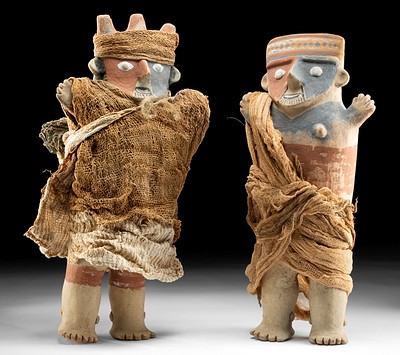19th C. Turkoman Gilt Silver Asyk Pendant w/ Carnelian
Lot 62a
About Seller
Artemis Fine Arts
686 S Taylor Ave, Ste 106
Louisville, CO 80027
United States
Selling antiquities, ancient and ethnographic art online since 1993, Artemis Gallery specializes in Classical Antiquities (Egyptian, Greek, Roman, Near Eastern), Asian, Pre-Columbian, African / Tribal / Oceanographic art. Our extensive inventory includes pottery, stone, metal, wood, glass and textil...Read more
Categories
Estimate:
$4,500 - $6,750
Absentee vs Live bid
Two ways to bid:
- Leave a max absentee bid and the platform will bid on your behalf up to your maximum bid during the live auction.
- Bid live during the auction and your bids will be submitted real-time to the auctioneer.
Bid Increments
| Price | Bid Increment |
|---|---|
| $0 | $25 |
| $300 | $50 |
| $1,000 | $100 |
| $2,000 | $250 |
| $5,000 | $500 |
| $10,000 | $1,000 |
| $20,000 | $2,500 |
| $50,000 | $5,000 |
| $100,000 | $10,000 |
| $200,000 | $20,000 |
About Auction
By Artemis Fine Arts
May 19, 2022
Set Reminder
2022-05-19 10:00:00
2022-05-19 10:00:00
America/New_York
Bidsquare
Bidsquare : Fine Antiquities | Ethnographica | Fine Art
https://www.bidsquare.com/auctions/artemis-gallery/fine-antiquities-ethnographica-fine-art-9350
Featuring a very special collection of Fine Art from the Hollywood Hills, including Picasso & Rookwood ceramics! Also included are many fine examples of classical antiquities, ancient, and ethnographic art from cultures encompassing the globe. Artemis Fine Arts info@artemisgallery.com
Featuring a very special collection of Fine Art from the Hollywood Hills, including Picasso & Rookwood ceramics! Also included are many fine examples of classical antiquities, ancient, and ethnographic art from cultures encompassing the globe. Artemis Fine Arts info@artemisgallery.com
- Lot Description
Central Asia, Uzbekistan, Afghanistan, or Turkmenistan, Turkoman (Turkman), Karakalpak, or Tekke peoples, ca. 19th to mid-20th century CE. This is a massive and gorgeous high quality gilt silver, carnelian, and glass pendant known as an asyk or ashik, a piece that is traditionally worn in the hair. The pendant is in the shape of a large palmette made of 78% silver and fire gilded with 66% (equivalent to 15K+) gold and 31% silver with 17 raised bezels containing citrine hued carnelian stones and glass. The front face is engraved with curvilinear patterns and decorative wirework, and at the tip is a large finial with 3 integral loops for suspension, and the additional heart shaped plates attached via a rod and rings to the main plate. These pendants were presented to women upon their wedding day to be worn on the back, suspended by the ends of plaited hair. Size: 16" L x 9" W (40.6 cm x 22.9 cm); silver quality: 31% on gilt areas and 78% on the rest; gold quality: 66% (equivalent to 15K+); weight: 907 grams.
Provenance: Whisnant Gallery, New Orleans, Louisiana, USA acquired prior to 2000
All items legal to buy/sell under U.S. Statute covering cultural patrimony Code 2600, CHAPTER 14, and are guaranteed to be as described or your money back.
A Certificate of Authenticity will accompany all winning bids.
PLEASE NOTE: Due to recent increases of shipments being seized by Australian & German customs (even for items with pre-UNESCO provenance), we will no longer ship most antiquities and ancient Chinese art to Australia & Germany. For categories of items that are acceptable to ship to Australia or Germany, please contact us directly or work with your local customs brokerage firm.
Display stands not described as included/custom in the item description are for photography purposes only and will not be included with the item upon shipping.
#169984Some fading and losses to gilt. Indentations and bending to silver rod on finial top. Areas of green oxidation and minor surface abrasions. Toning and dark patina throughout. Carnelian stones are intact, and plates are secure. Approximately 4 of the "stones" are carved from glass.Condition
- Shipping Info
-
All shipping is handled in-house for your convenience. Your invoice from Artemis Gallery will include shipping calculation instructions. If in doubt, please inquire BEFORE bidding for estimated shipping costs for individual items.
-
- Buyer's Premium



 EUR
EUR CAD
CAD AUD
AUD GBP
GBP MXN
MXN HKD
HKD CNY
CNY MYR
MYR SEK
SEK SGD
SGD CHF
CHF THB
THB














